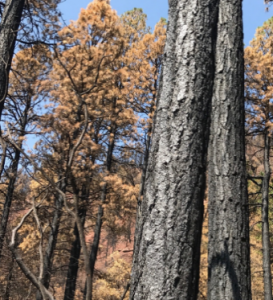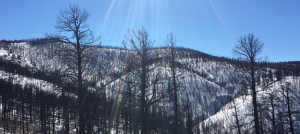After the Fire: Finding Value in Burned Timber within the 2-3-2
by Tim Reader

In 2018, Colorado and the West experienced one of the worst wildfire seasons on record. Even though a lot of resources are put towards conducting fire mitigation needed in the WUI (Wildlife Urban Interface), our Team is identifying a need to address wood and biomass utilization needs after fires occur. While assigning resources after the fact may not sell to some stakeholders strategically (“why are you spending time and resources once a fire has happened instead of spending that time and resources making sure a fire didn’t happen”), support for communities post fire, particularly in the arena of offering landowners options to removing and using their burned trees is definitely a prevalent community concern.
We recently had the opportunity to address this response with a field tour of some of the burned neighborhoods within the Spring Fire outside of La Veta, Colorado (eastern border of the 2-3-2 Cohesive Strategic Forest Partnership boundary landscape in south central Colorado).

It was a cold, crisp day with fresh snow on the Monday following Thanksgiving weekend. (The fresh snow part is important to remember later!) The tour was led by our Community Biomass Enterprise Development Team members: Tim Reader, Kurt Mackes, and Randy Johnson. We met collaboratively with Colorado State Forest Service foresters in the area to discuss options for the removal and utilization of the trees burned in the 90,000 acres plus of private property (the fire also burned over 130 homes). Our collective team did outreach prior to the tour based on some of our successes after the Black Forest Fire in 2013, evaluated the situation during the tour, and are continuing to work together on developing recommendations for possible actions after the winter.

Standing burned trees are hazards to the property owners, are difficult to remove without professionally trained contractors, and result in decreasing property values. The good news is that just because the trees are burned, does not mean that the wood can’t be used and manufactured into lumber and other wood products. It simply forces the focus and need to act quickly as the wood usefulness timeline is shorter than unburned trees. The wood in burned trees loses moisture quickly, resulting in cracks and splits making it unsuitable for making lumber and other wood products unless harvested within the first few years following a fire. Our Team evaluated the amount of merchantable timber post Spring fire. The new mill in the vicinity, Blanca Forestry Products, is helping in the utilization of the burned trees on some larger properties, but they must work fast as recovering any value from these trees is probably only a one or two year window.
Since the Blanca Mill cannot profitably provide smaller property owners a possible outlet for the removal and use of their burned small-diameter trees, the CCC Community Biomass Enterprise Development Team is investigating a mobile sawmill platform, one that can be set up and operating within the burn area itself, to increase the amount of wood utilized from the smaller trees. We looked at species mix and categorized the sizes of timber logs for merchantability. Another component to consider is the lay of the land for logistics of moving equipment around and the percentage of steep slopes that exceed 40%, making it difficult to mitigate that land with either equipment or hand-felling. The varieties of species mix included Douglas-fir, White fir, Ponderosa pine, Lodgepole pine, and a small amount of Aspen.

It would be great if 100% of what we found that day had a monetary value, but unfortunately, there are great portions of smaller diameter biomass that would simply be more cost effective to masticate in place with a service agreement paying a contracting company. The goal would be to find enough value in larger timber to offset those costs for the landowner. Other considerations for the mobile sawmill are the fact that burned timber can dull their equipment a lot faster than regular timber.

Our CCC Community Biomass Enterprise Development Team tour was a success in collaboration by getting several experts to view the landscape to determine potential safety hazards, identify areas where burned timber had some value based on their different sizes/species, and share information amongst each other to determine challenges and proposed next steps. The other collaborative effort of the tour day was some of the forester posse towing my vehicle out of the snow after I managed to get it stuck on a snow-covered dirt road while viewing properties. Much gratitude for that collaboration as well!
With wildfires continuing to be a part of our future living in Colorado, our team is working to be an important resource after the fire to both landowners and small businesses in the biomass community.

